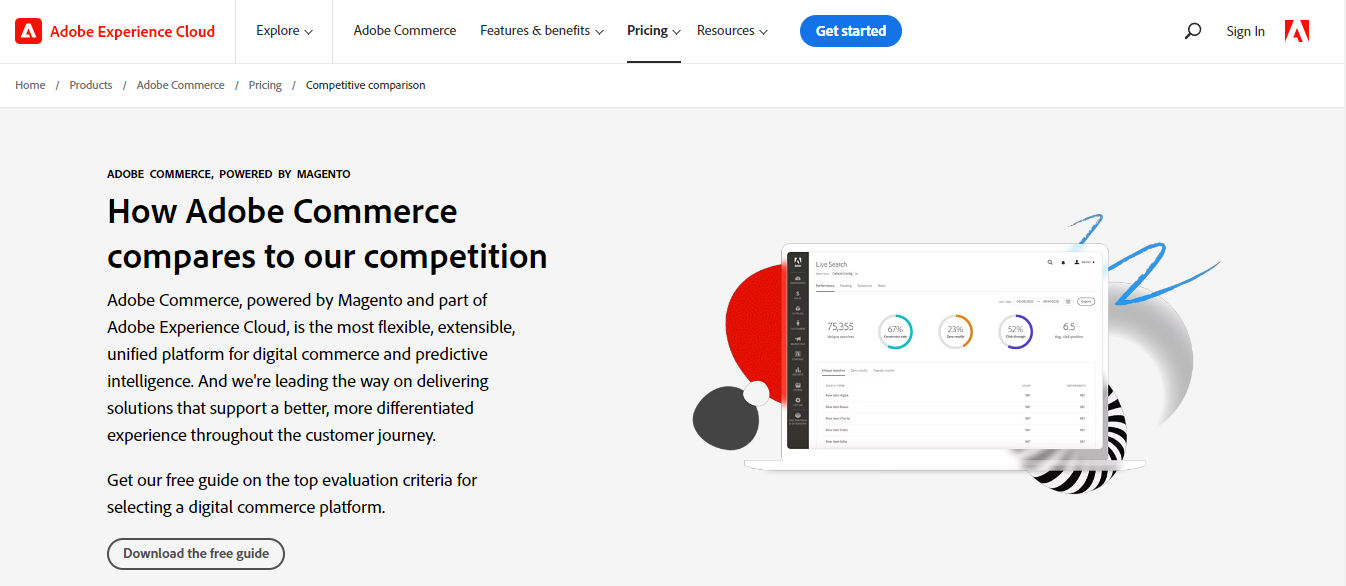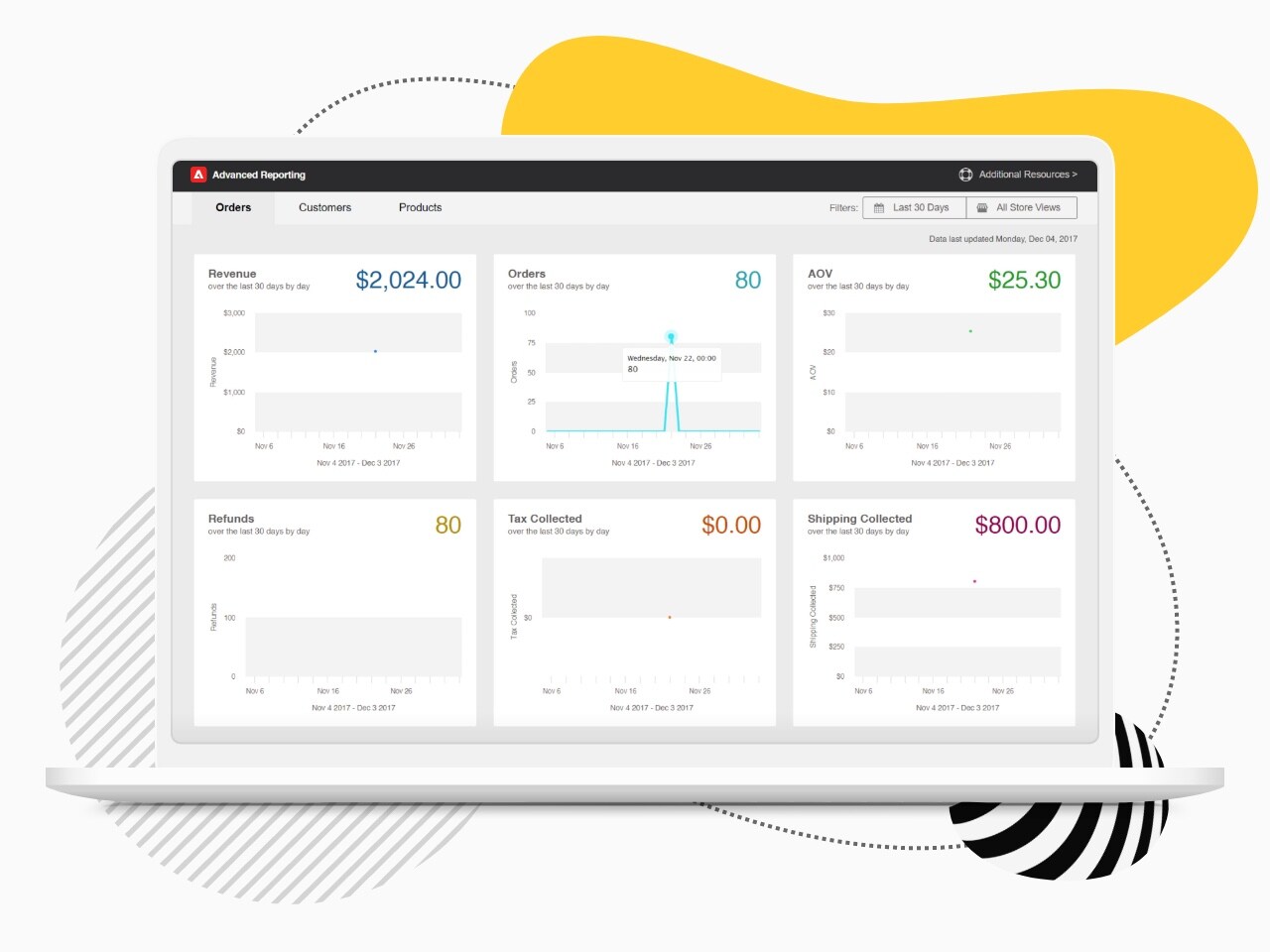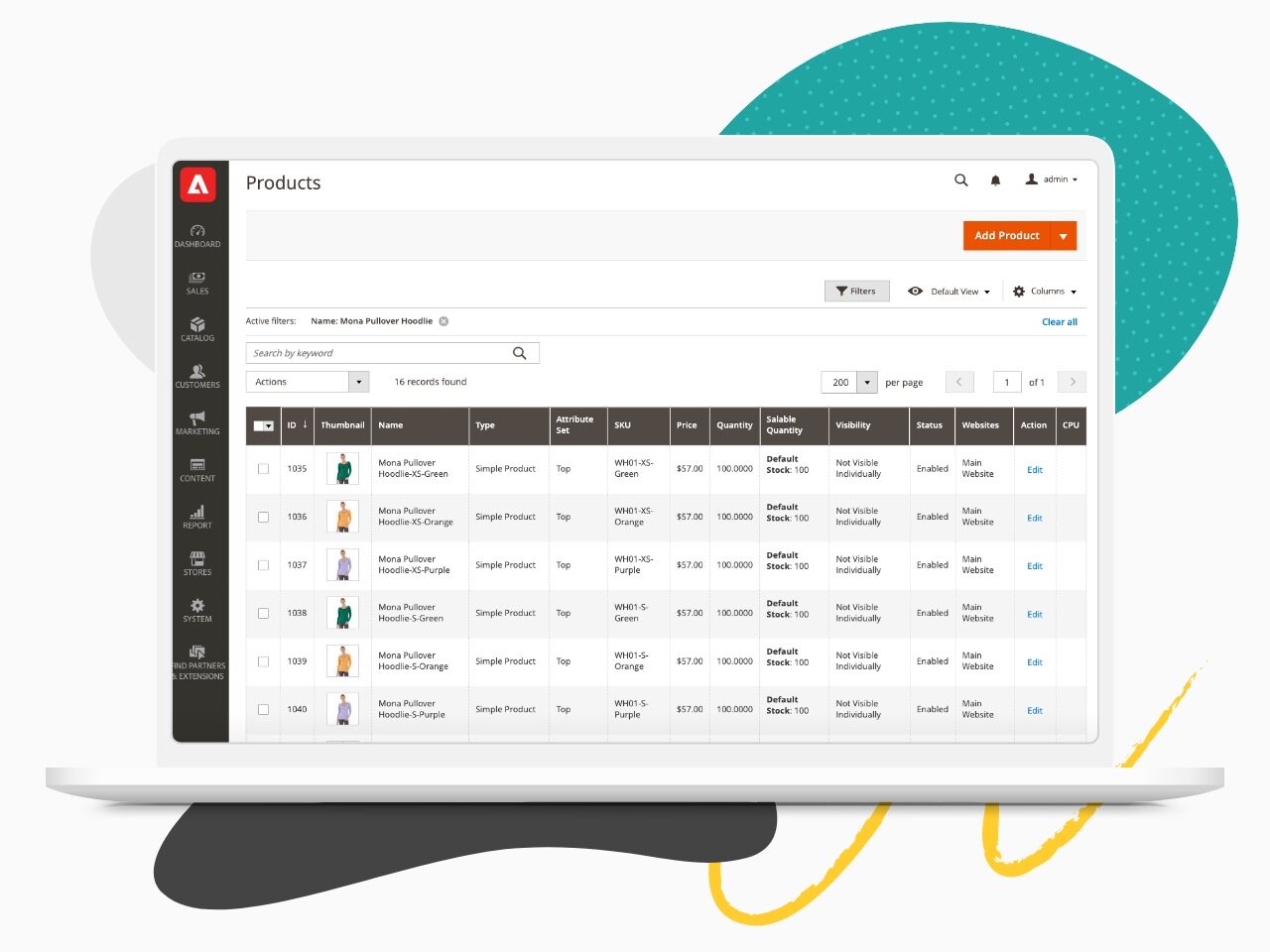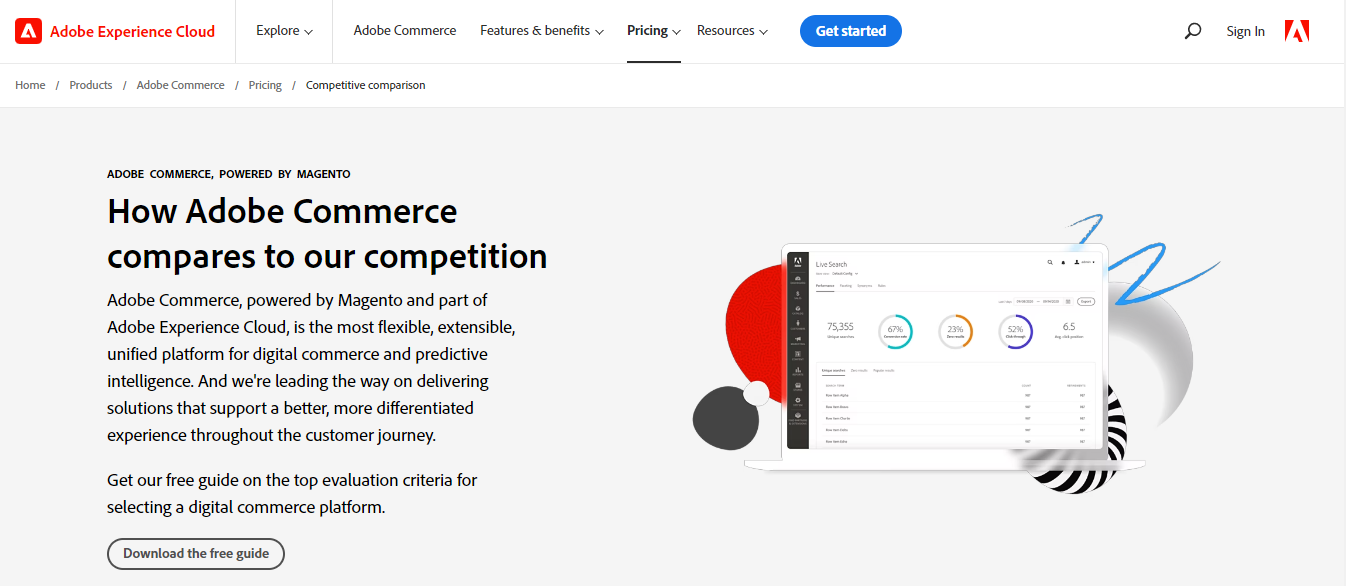

Adobe Commerce Reviews & Product Details
Adobe Commerce (formerly Magento) is a hosted and open-source product and is one of the biggest website builders today, with major blue-chip brands like Nike and Cisco among its roster of clients. The Adobe Commerce environment is also scalable, however, it does require some coding knowledge to maximize. The platform has a lot of customization options and offers trigger-based automated marketing features and automatic cross-selling and upselling features.


| Capabilities |
|
|---|---|
| Segment |
|
| Deployment | Cloud / SaaS / Web-Based, On-Premise Linux, On-Premise Windows |
| Support | 24/7 (Live rep), Chat, Email/Help Desk, FAQs/Forum, Knowledge Base, Phone Support |
| Training | Documentation |
| Languages | English |







Magento definitely gets the job done, no doubt about that. There's a lot of in-depth details, you can even manage your newsletter subscribers from there and do a lot through various extensions.
Honestly, Magento's inventory system is horrible. Can't express this enough. Our company has done manual inventory to try and override this, and even though we turn Magento's inventory off, it finds a way to turn itself back on and undo all the hard work we've done.
We use magento to take customer orders, which is crucial to our business. Without it, we wouldn't have an e-commerce platform.
The order processing functionality in Magento is very easy and user-friendly. Invoicing, Canceling, and Returning orders is quick and straightforward. I also like the the UserID function within product listings which helps us label products and manage our listings.
The merchandising functionality in Magento Commerce leaves much to be desired. Improvements could include - sold outs automatically falling to the bottom of the category while retaining merchandise order on the page, disabled/enabled and quantity information appearing in the tile view of merchandise categories, as well as product export from categories.
Magento is the base of our E-commerce business, allowing us to upload, manage, merchandise, process orders, and sell products.
Magento BI actually syncs with Google Analytics and leverages that data, along with data from many other platforms: Facebook Ads, Mixpanel, NetSuite, Salesforce, Trello, and Zendesk (to name only a few). As a marketer, this is HUGE. Instead of checking each separate platform, all data is collected and available to analyze in Magento BI. You no longer need to worry about running cross-platform comparisons when Magento and Google Analytics sales data doesn’t match.
Doesn't provide support fo different visualizations.
Da y to day problem
The layout is professional looking and using it for day to day tasks is second nature to me now.
Sometimes slow and there are certain features that don't make it clear what they are for.
On hold orders, change of address, questions and reviews from customers, avatars, adding products to blog posts.
I like that the sales/ecommerce portion is fully integrated right away.
If you do not constantly update you will fall so far behind you won’t be able to get it up to speed and functioning properly.
Having an ecommerce site.
Magento has a lot of features, some great themes, and frankly makes a professional-looking ecommerce website that makes our company seem much bigger than it is.
Many of what you might consider basic features are only available as third-party plugins and while they may work great individually, they frequently don't play well together. If you do not have a dedicated developer, be prepared to pay a not-insignificant amount to hire someone to work on your site. If you only need a simple site, this won't apply to you, but then you also have no reason to use Magento when simpler, more stable products are available.
We outgrew our previous ecommerce platform and we made the move to developing a Megento-based site. Our business has a wider range of products and services than most, and the smaller platforms were not configurable enough for our needs.
Once you get the hang of it, Magento is pretty easy to use.
It is very difficult to figure out how to do basic things. It is also difficult to batch upload products. The CSV upload form is very lengthy and takes a long period of time, and still does not upload into the system correctly. The specifications for images and product information are very specific. Magento itself is very basic and you have to individually purchase and set up plug ins in order to have standard services on e-commerce sites such as customer reviews. It is also very difficult to create basic promo codes that are standard for other e-commerce websites, such as buy one get one free.
With magento we were able to understand a lot about our customers once we had it set up correctly. It greatly helped our customer service end since it was very easy to access a lot of customer information.
Overall its good for customization and perfect for companies who want to expand their process flow to meet business needs
Requires deep learning curve in order to customization any modules. The infrastructure not that friendly, you might need the expertise to do the jobs
Integration with existing warehouse system and other in-house software/systems
Magento allows for a seamless e-commerce experience.
There's not much that I dislike about Magento other than the price tag.
some of the benefits are how detail oriented the site is and also how i can see analytics easily.
I like that the details and back end information is there and easily accessed
how i am not able to move around products easily on the site
It provides benefits on selling our products not only in person but as well as online
Don't get me wrong, I think magento is extremely great to handle website, store and logistics.
But, it surely needs to be easier to use. We are implementing it since a very long time now with a lot of bugs.
We increased our sales and we manage our entire website more easily than before.
Promotions and Catalog features are great. Extremely impressed with the capabilities it enables for marketing an assortment of products.
From a branding and content perspective, Magento severely lacks. Also, there are many out of the box features that just don't seem to be user friendly or are simply missing, and should be present.
Looking to move to a global platform that allows consistency across regions for a variety of brand products, plus allows quick sites in the market place. Unfortunately, in order to use Magento the ability that we want to (in terms of branding and content marketing) several customization had to be made. This makes the platform even slower than it is out of the box, plus makes upgrading extremely costly. We were not aware of these limitations at the start of the project, and now we are looking at a HUGE time to market and significant cost to do the simplest of tasks, like staying up to date and PCI compliant. I would never recommend if a company wants to do any type of robust content marketing or personalization in any capacity.
The simplicity of the front end and the inventory management
The difficult to navigate admin console and menu system
e-commerce / online shopping store
The setup process is pretty straight-forward. It did encounter some bumps that I had to just dive deep and figure out for myself as the documentation was poor. I liked the order customization I received and the custom shipping and tracking options.
I believe the documentation was lacking. It looked more like a changelog and less like a manual. I needed to navigate user forums to find help for basic issues. These basic ideas and issues could be included in a DOC file to make start-up easier and less daunting of a task for the end user. This delayed roll-out because I could not change a simple header bar..
Product placement on the website and order management. Magento has been great for this use.
Most of the function can be customized to your need
It needs the professional developers to make the customization you need and it takes time
Full customized shop with magento platform and user-friendly interface frontend
It works really good, i wish there was a way to make pages reload faster.
Pages load really slow, whether it's chrome, firefox, etc
Processing orders and exchanges
I like that it is simple to break out roles and limit/expand access to users within the platform.
It is not the easiest to use, updates are a pain and the support team is no good.
Having an e-commerce platform, it is nice to be able to view customer orders within the system instead of only having them in the cms.
I liked that the user interface wasn't too difficult to learn. Once logged in, you can pretty easily find your way around. My job was to keep the product images on the company's website up to date, as well as add and edit product descriptions. This was fairly easy to do and didn't take to long to figure out.
The software would sometimes give you error messages when trying to save product details if there was something wrong with the product specs. Never was able to figure out what the problem was and most times would just have to exit without saving. Seems like you should be able to edit a product description without having to edit the product specs. Hopefully this is something they'll fix if they already haven't.
This makes it quick and easy to add and edit products for an e-commerce site. I think it's simple enough that simple tasks, like adding and editing products, can be distributed to others in the office who might not have coding or design knowledge. This would allow updates to be made much quicker than if just one or two are working on it.
The user interface is clean and sensible, and was easy to learn.
There are a lot of bugs in version 2.1, we've had to pay a lot of money to have an outside company fix and customize it for us.
I wouldn't say it's solving business problems. It serves as a software service that allows our business to run an e-commerce store.
Contains all required information, name address, items, total etc.
The lack of it to import to our other program where actual patient charges are made.
Organizes information in a clear manner. With the search we can search by state.









